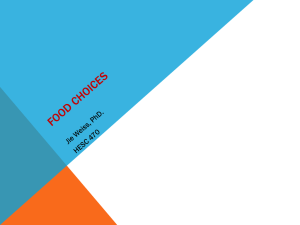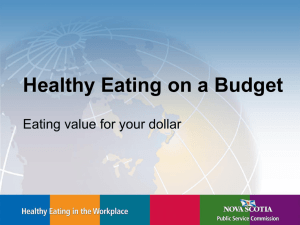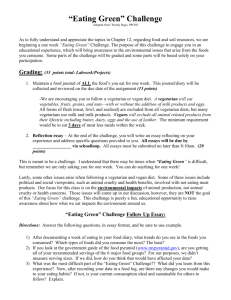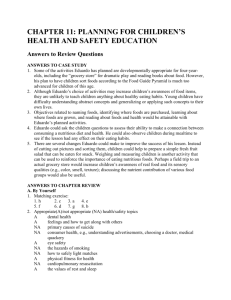How did we get to this point? - Go-Med
advertisement
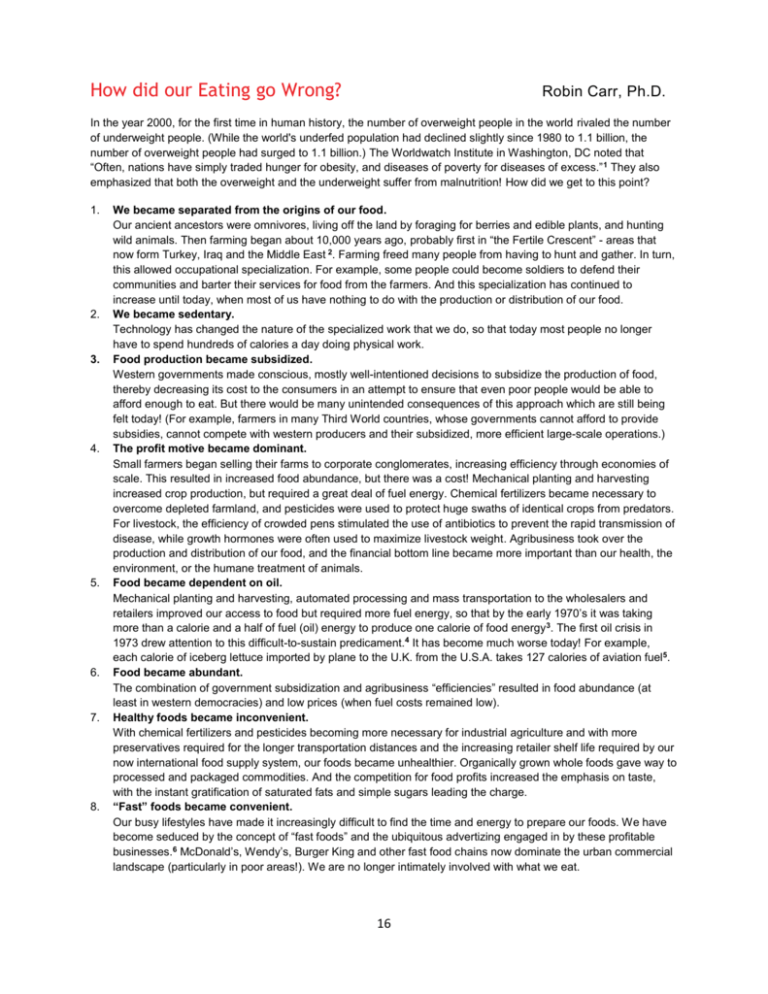
How did our Eating go Wrong? Robin Carr, Ph.D. In the year 2000, for the first time in human history, the number of overweight people in the world rivaled the number of underweight people. (While the world's underfed population had declined slightly since 1980 to 1.1 billion, the number of overweight people had surged to 1.1 billion.) The Worldwatch Institute in Washington, DC noted that “Often, nations have simply traded hunger for obesity, and diseases of poverty for diseases of excess.” 1 They also emphasized that both the overweight and the underweight suffer from malnutrition! How did we get to this point? 1. 2. 3. 4. 5. 6. 7. 8. We became separated from the origins of our food. Our ancient ancestors were omnivores, living off the land by foraging for berries and edible plants, and hunting wild animals. Then farming began about 10,000 years ago, probably first in “the Fertile Crescent” - areas that now form Turkey, Iraq and the Middle East 2. Farming freed many people from having to hunt and gather. In turn, this allowed occupational specialization. For example, some people could become soldiers to defend their communities and barter their services for food from the farmers. And this specialization has continued to increase until today, when most of us have nothing to do with the production or distribution of our food. We became sedentary. Technology has changed the nature of the specialized work that we do, so that today most people no longer have to spend hundreds of calories a day doing physical work. Food production became subsidized. Western governments made conscious, mostly well-intentioned decisions to subsidize the production of food, thereby decreasing its cost to the consumers in an attempt to ensure that even poor people would be able to afford enough to eat. But there would be many unintended consequences of this approach which are still being felt today! (For example, farmers in many Third World countries, whose governments cannot afford to provide subsidies, cannot compete with western producers and their subsidized, more efficient large-scale operations.) The profit motive became dominant. Small farmers began selling their farms to corporate conglomerates, increasing efficiency through economies of scale. This resulted in increased food abundance, but there was a cost! Mechanical planting and harvesting increased crop production, but required a great deal of fuel energy. Chemical fertilizers became necessary to overcome depleted farmland, and pesticides were used to protect huge swaths of identical crops from predators. For livestock, the efficiency of crowded pens stimulated the use of antibiotics to prevent the rapid transmission of disease, while growth hormones were often used to maximize livestock weight. Agribusiness took over the production and distribution of our food, and the financial bottom line became more important than our health, the environment, or the humane treatment of animals. Food became dependent on oil. Mechanical planting and harvesting, automated processing and mass transportation to the wholesalers and retailers improved our access to food but required more fuel energy, so that by the early 1970’s it was taking more than a calorie and a half of fuel (oil) energy to produce one calorie of food energy 3. The first oil crisis in 1973 drew attention to this difficult-to-sustain predicament.4 It has become much worse today! For example, each calorie of iceberg lettuce imported by plane to the U.K. from the U.S.A. takes 127 calories of aviation fuel5. Food became abundant. The combination of government subsidization and agribusiness “efficiencies” resulted in food abundance (at least in western democracies) and low prices (when fuel costs remained low). Healthy foods became inconvenient. With chemical fertilizers and pesticides becoming more necessary for industrial agriculture and with more preservatives required for the longer transportation distances and the increasing retailer shelf life required by our now international food supply system, our foods became unhealthier. Organically grown whole foods gave way to processed and packaged commodities. And the competition for food profits increased the emphasis on taste, with the instant gratification of saturated fats and simple sugars leading the charge. “Fast” foods became convenient. Our busy lifestyles have made it increasingly difficult to find the time and energy to prepare our foods. We have become seduced by the concept of “fast foods” and the ubiquitous advertizing engaged in by these profitable businesses.6 McDonald’s, Wendy’s, Burger King and other fast food chains now dominate the urban commercial landscape (particularly in poor areas!). We are no longer intimately involved with what we eat. 16 9. Portion sizes increased. Abundant cheap food and the need for restaurants to compete against each other resulted in ever-increasing portion sizes in restaurants and, ultimately, in the expectations of our brains. 10. Food advertizing became ubiquitous. Not only did food become abundant, but so did the advertizing of it by fast-food outlets, restaurants and grocery store chains. Even when we’re not eating, we are constantly presented with images of food in our environment. Magazines, television and billboard ads continually present images of food that appeals to our taste buds. 11. Behavioral changes related to eating occurred. A series of cultural changes occurred that, often by accident, increased the likelihood of our becoming fat and unhealthy. For instance, a century ago eating was a social activity, often involving friends and family sitting around a table eating and talking. The talking would slow down our eating, giving time for stomach stretching (due to the food eaten) to turn off our hunger. Today, we are much more likely to be eating alone, often when we’re hungry, and we’re likely to gulp down our food quickly before giving time for our feedback mechanisms to let us know that we’re full. Another example is eating while watching television. Like Pavlov’s dogs, we may begin to associate the two behaviours so that eventually, whether we’re hungry or not, we may want to eat every time the television is turned on. 12. “Foodies” perverted the virtues of taste and presentation. While the taste and presentation of foods is of course an important component of how and why we eat, many famous chefs, food reviewers and other celebrities have focused exclusively on these characteristics while ignoring the environmental costs of their favourite dishes (e.g. shark fin soup) and the horrific animal abuse that is involved (e.g. as with veal and foie gras). 13. Unscientific myths were propagated. In the 19th century, protein was synonymous with meat. Early scientists like the German Carl Voit (1831-1908) found that “man” needed only 48.5 grams/day, but he recommended 118 grams/day. 7 (He obviously came from the “If something is good, more is better!” school of thought.) Well-known nutrition researcher Max Rubner stated that “a large protein allowance is the right of civilized man,” 8 (hmmm! Food is a right?) and that protein intake (to him, meaning meat) was a symbol of civilization. The cultural bias was set. If you were rich, you ate meat. If you were poor, you ate staple plant foods like potatoes and bread. For over half a century now, the meat industry has promoted their products in often unsavory ways, first by suggesting erroneously that meat protein was superior to plant protein, and more recently by vacuously associating meat consumption with masculinity and sex appeal. (A 2010 Taco Bell television commercial for the chain’s Bacon Club Chalupa has one attractive young woman giving advice to another: “Men like bacon!”) The dairy industry has perpetrated its own misleading selfpromotions over the last few decades, coming close to stating that mothers are not looking after the health of their children if they’re not giving them cow’s milk. (Did millions of years of evolution really make us dependent on the milk of another species?) As a result of all this nonsense, western nations shifted towards a diet comprised much more heavily of animal protein. And now developing countries are making the same mistakes! References: 1. 2. 3. 4. 5. 6. 7. 8. Worldwatch (2000) Underfed and Overfed: The Global Epidemic of Malnutrition. Paper #150: Worldwatch Institute, Washington, DC. Wikipedia, History of agriculture. http://en.wikipedia.org/wiki/History_of_agriculture (retrieved Aug 6, 2010). (1973) Personal communication with an editor of the Economist journal. Green, BM (1978) Eating Oil: Energy Use in Food Production. Boulder, CO: Westview Press. Church N (2005) Why our food is so dependent on oil. Energy Bulletin: Post Carbon Institute http://www.energybulletin.net/node/5045 (retrieved Aug 6, 2010). Schlosser E (2001) Fast Food Nation. New York, NY: Houghton Mifflin Company. Voit C, quoted in Campbell TC & Campbell TM II (2006) The China Study. Dallas, TX: BenBella Books, p 28. Rubner M, quoted in Campbell TC & Campbell TM II (2006) The China Study. Dallas, TX: BenBella Books, p 28. This article first appeared on the web site “Saving the Canadian Health Care System”, as part of a larger article. http://www.savinghealthcare.ca/articles/a-guide-for-eating-for-active-health 17





